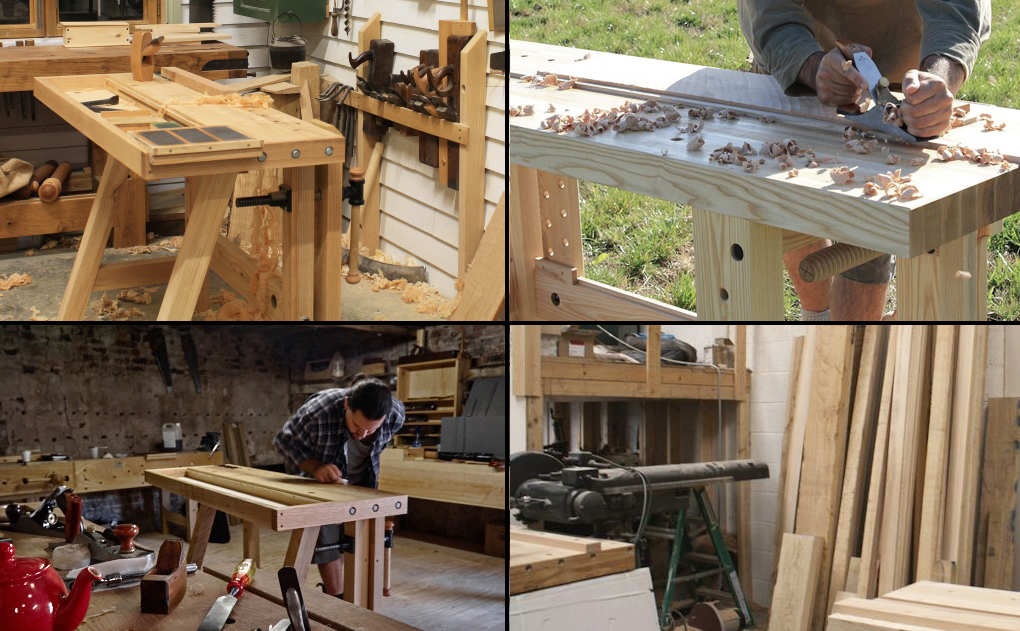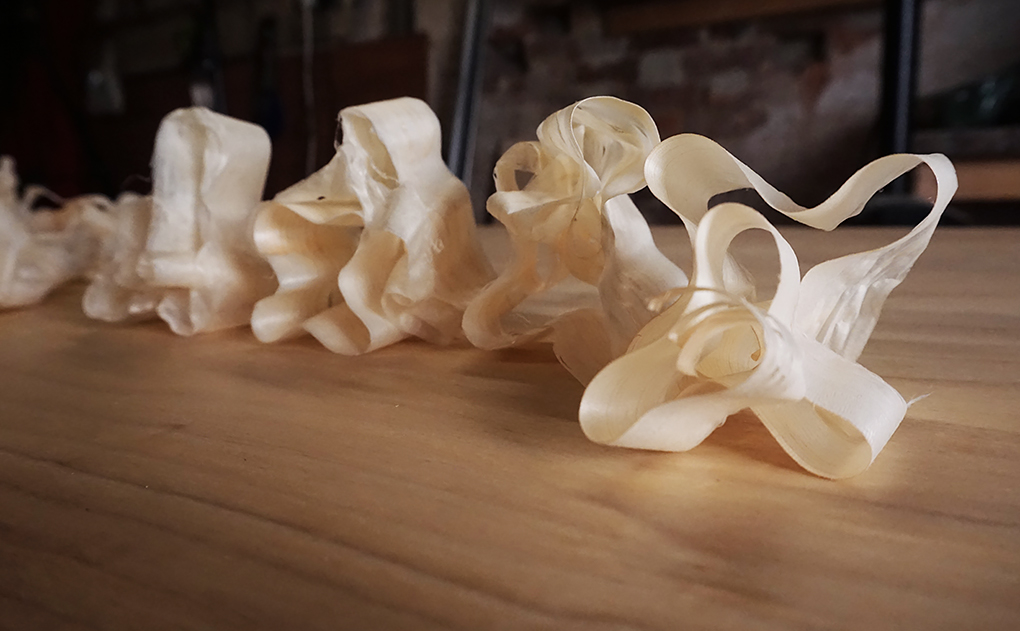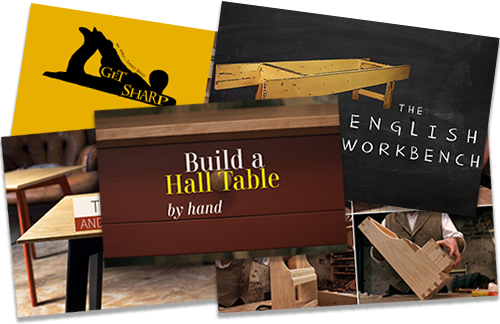As you know, to become fast with hand tools you have to understand that perfection isn’t a thing.
You need to learn where the inaccuracy can be hidden, and deliberately place it there.
A good example of this, were those table legs in the hall table build. Getting them perfectly square would have been a faff, so I didn’t even bother to try. Instead I deliberately made them out of square, but made sure that I put that error in to my favour. That deliberate error then became an huge advantage for the joinery and the rest of the build.
In the finished piece you wouldn’t be able to tell. And that’s the key.

Roughing It By Machine
Once this skill is mastered, you then realise just how over the top we can get about precision when it comes to machines.
My planer has a dial on it that goes down to 1/10 of a mil! When you thickness by hand do you ever even measure the thickness at all?

Now, don’t get me wrong, having that sort of accuracy is handy, particularly in a production environment. It’s also nice with those who can’t cope with odd numbers.
But for the one man maker it’s rarely needed. And when it is, you’re proficient with a hand plane, and can get far more precise than that using one.
What I’m trying to say here, is that buying machines for a hand tool workshop is massively cost effective.
The reason is, we don’t need to be paying for that precision.
If we’re going to be using machines, then it’s for their speed in roughing out. All of our finishing is still going to be done by hand and that’s where we (hopefully) excel.

My old fancy planer. It’s very accurate, and it was great when I was using it to knock out workbenches. But I’d easily get away with a far rougher machine now that I’m back building furniture.
I do love that dial gauge on it though. I can’t even help myself but go to precise numbers.
Things inside there had rusted up pretty bad, due to it not being used for such a long time. I had to spend a fair while getting it whirling back in to action recently. I’ll be using it in my next build, so I’ll let you know the reasons for that shortly.

![Simple Work Holding For Ploughing Grooves [Without a Tail Vice]](https://www.theenglishwoodworker.com/wp-content/uploads/2022/07/workholding-without-tail-vice-copy.jpg)



That’s what I use a table saw for. If I got a lot of the same sized stuff to do I just rip them out and then plane the pieces to size
What sets truly hand made apart from machine made is just that, “handmade.” The machinists also say that they employ machinery for all the rough milling and some go as far as using the term “handmade” as they constitute that they used their hands to push the work through a machine. I personally believe that this is misleading and none of it constitutes to truly handmade anything. What people do in their own workshops for themselves for their own pleasure is their own business. But what people do in their workshops for others is the business of their customers. People pay extra for a truly handmade item. It’s that human element of touch and skill that they pay for and of course beauty and functionality. That’s my understanding of handwork. It’s laborious truly hard back breaking work but the pleasure of seeing a piece come together still astonishes me and I always amaze myself that I did that with my own hands.
great comment! there should be a commercial regulation on ‘handmade’ labeling. I inform my customers that my work is handmade and with no electricity… that’s something that effectively put the focus on the real situation of doing things by hand.
But this is a rabbit hole. Do you rive your stock? Was the tree felled with an ax or a chainsaw? How Was the log moved out of the forest? On and on. Me, I use a bandsaw and a planet to make furniture and if I sold it I’d call it hand made. I don’t use a router because for the stuff I build it doesn’t save much time and is unpleasant to use. In the end, I think “hand made” is just shorthand for “not some kind of toxic composite dreck shaped by robotic CBC and designed to literally fall apart within five years”.
Agree 100%
Or just film your self during the making of a piece for a customer constantly from one angle as evidence and place it on a memory stick which you give to the customer with the piece. It will be a boring video though but it will still be evidence.
In quebec the regulation to call a handmade product if I remember well is 35% of the whole process need to be done by hand which is usually the finishing step.
I am using the plane I built last year from your plane build plans. Mine’s made from Swiss pear and I am using grandfather’s iron and chipbreaker from a 1931 Bailey he passed down. I dearly love using this plane!
I often make shop gifts in amounts for family members so I use machines in my ‘production environment’ in that way. Otherwise, I use hand tools for many of parts of the jobs. I prefer flattening boards on one side using hand planes before using my thickness planer make the other side parallel for example. And, I can’t afford a wide jointer anyway and hate to cut wide boards to fit them on my benchtop jointer.
Yes machines such as jointer and plane.r let me get to the creation bit quickly! More quality time!
There is nothing wrong with using a machine, a table saw, a band saw, a sander, several power hand tools (useful to use planer to get a smooth finish on sapele) but working as I do in a very limited space the faff of getting the power tools out and in a safe user space means it is often better just to use a hand tool!
Where did all the old Wadkins go? I’ve been waiting for years now to see them come into use..
Tend to agree to some extent. I use both machines and hand tools. I rough large boards, which are usually twisted, by hand, using an old (100yr about) German fore plane with a lethally sharp curved iron and winding sticks, finishing with a No 7 Recprd. Then the other side is flattened with my Makita planer/thicknesser..
I have a 12 in Wodman table saw and a Bosch 12 in drop/mitre saw.
However I sharpen all my edge tools myself – to polishing on leather strops a la Paul Sellars, I have aselection od wooden and metal planes, the former all have been given the Paul Sellars treatment. My latest refurb job, a Stanley No 3, probably 50 years plus old, cuts a 0.1 mm thick curl off a 1 inch board.
I also cut my own dovetail by hand again using techniques seen on the various web videos. So a bit of both I say..
Do you have an address to which I can send you some photos of my Waterfalll stool build?
Only thing i needed was the work bench from your plan. Small workshop for making sundials and bench for woodwork jobs around house and gardens only. sundials I make from brass and engrave to set on cast stone pillars .One per week for friends. Barter system in place for timber and hen corn. Works a treat and lazy all winter with all done and dusted. I write my blogs and study history my first love. Glad your machine is back in harness should prove useful.
I’m making a TV unit at the moment. And I’ve been making large ‘wooden tiles’ from ash. I’m shaping them like pyramids. Starting with a rough sawn board on a thicknesser on one side only. Then I did everything else by hand. But that initial flat face made everything else that much faster. It’s my first time using a machine.
Interesting philosophy,however, it may not apply when creating Kumiko art pieces.
I have the baby brother of your machine in the Hammer series. Wouldn’t pass it up for anything on rough stock prep. It pulled a 250x 50×4000 jarrah beam through ( I do a bit with recycled timber) Accurate and built pretty bomb proof for the size. To be honest prepping lots of recycled hardwood by hand can really suck. Smaller projects fine, sometimes less faff to do it on the bench. I use a Makita electric plane for rough prep as well. It takes all the nasty old crud off including a lot of the inevitable sand ingrained in the surface (yeah, still there even after a scrub down, we do sand really well in Western Australia ) .
Substituting apprentices with power tools for the grunt work.
We are fascinated with the history of hand tools and how artisans use 30 year old drills, jig saws and table saws but also cut dovetails and mortise and tenons with a chisel and handsaw! This explores the time when 1/2 inch plywood was actually 1/2 inch thick and mentions now obsolete tools like the radial arm saw.
https://gg.gg/allwoodworkingtoolsManual.
I took up hand tool woodworking for mostly therapeutic reasons and because I thought it would strictly be a “slow hobby”. I imagined never using machines and saw some value in being a hand tool purist. Then I found myself with a long list of projects for our home with many being better fit for plywood than lumber. The plywood is brutal on most hand tools and slow for repetitive tasks so I built a very small arsenal of good quality workhorse cordless power tools plus helpful accessories and am glad I invested. My Stanley no. 5 and Disston hand saws are relieved as well. I plan to take a thoughtful approach to using machines when I move from building cabinets and climbing gyms and toys for my little one back into my original interest in designing and building furniture. Your input is quite helpful. You are spot on with the idea that machines just need to get us “close enough”, saving valuable time, without killing the beauty of handmade or the pocket book. Thanks as always for your insights. Hope you all are well given the current mess we’re all in.
In my opinion if you assemble your parts for a project either by machines or hand and from there completed The project with hand tools then it’s hand made , a machinist would use machinery to cut dovetails a Morticer or router to cut mortises a table saw to cut tenons ect
If I run 4 boards across a jointer and thicknesser to get down to size I need all I have is 4 boards square and parallel boards however if I then proceed to complete all joinery with hand tools . Then I have a hand made item 😀
Richard & Helen,
looking forward to the new vid. series.
hope all is well in your crazy world and you are both healthy?!
regards
Michael
Let us not be snobs and tight-arses about this, folks! Use machines as much or as little as you please, but do NOT take a leak in other peoples pools! If you do wood turning with a lathe you have to foot-pump, fine. If you have an electric driven one, fine. I draw the line with a CNC lathe though.
If you use a wooden scrub plane made from one of the thieve’s crosses (relax, I am christian myself), fine. If you put your wood through a machine to get to 4S, fine.
Where we part ways is the point where jigs need to be built in order to be able to use a machine in stead of hand tools, to the point where using a chisel to make a rabbet would actually be faster. If the goal is to be able to avoid using hand tools at any cost, get out of my shop. Otherwise, enjoy!
I do not plan to aquire moulding planes of every sort, so I’ll use my router and bits for that the few times I need them. The piece will still be considered hand made.
Of course, this is MY opinions, and they really do not matter to anyone but myself. But there they are. 🙂 I really find it both hillarious and sad when well-known woodwor…machinists perch on top of a ladder in order to be able to route the tenon on the end of a bed side rail… 🙂 “No hand tools where blunted during filming of this episode!”
The Vidar rant is over for now. 😉
Perfection isn’t a thing – you nailed it! This is especially true in woodworking. Machines can make your work easier and a lot faster. But there’s a certain charm to “imperfect” handmade products that makes them more appealing. But that’s just my two cents.
What really makes me tick is the realisation that things don’t always have to be perfectly flat, or perpendicular, or whatever, to produce a finally fine result. Your – on purpose – unsquare table legs, and unbalanced tenon shoulders were a real eye opener. For me this opens the way to more fun and freedom with quiet hand tools, in contrast to undending tuning of noisy power tools in search of a (sometimes) futile exactness. I now use my power tools mostly for roughing, or for working engineered stuff like plywood. I am learning do be precise only when it’s needed and I deeply thank you for that, Richard.